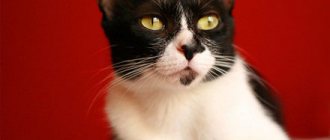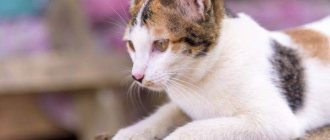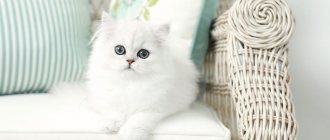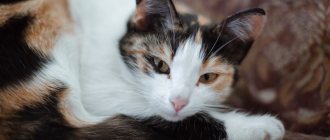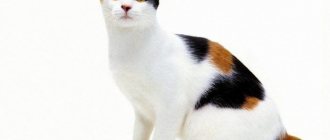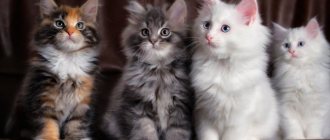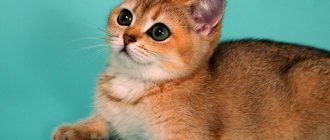What is tortoiseshell coloration in a cat?
The fur coat of a tortoiseshell cat combines a variety of shades from the black and red palette. It is covered with multiple multi-colored spots and stripes, differing in size and shape.
It is important to note that black points (colored areas) always have clear boundaries, while red points are always blurry. The eyes of such cats are usually orange or copper-gold, and the color of their nose and paw pads coincides with the predominant color of the color.
After such a description, many may have a misunderstanding about where the white color went. After all, very often it is he who decorates the “three-flowered” fur. The thing is that, from a scientific point of view, this term refers to the absence of color. White animals lack the pigment responsible for coloring their hairs.
Golden colors
The golden series of colors of British cats is divided in the same way as the silver. This type was developed relatively recently, which explains many controversial issues in the classification. In the golden variation there cannot be red and cream shades of wool. The undercoat of golden cats is not white, like silver cats, but a rich, warm cream or apricot color. The hair has black (optionally: brown) tipping on the head, back, tail and sides. The cat's chin, ears, chest and belly are soft apricot, nose? brick, paw pads dark (brown to black). The tipping on the tail is deeper than on the rest of the body. The eyes must be green. The mirror of the nose is reddish in color. Tabby markings are acceptable on kittens. In adults? the letter "M" on the forehead, as well as closed rings on the legs and tail and an open necklace.
Genetic conditioning and inheritance
Speaking about color, it is necessary to clarify that this concept covers not only the color of the fur, but also the pattern on the fur coat. Melanin is responsible for the pigmentation of these zones, which is divided into 2 types:
- eumelanin, which gives black color due to the absorption of light rays;
- pheomelanin, which produces a red-yellow spectrum due to the reflection of light rays.
The appearance of an animal directly depends on the inherited genes. The listed pigments are contained in the X chromosomes and can give the following color options:
- black(oo);
- red (OO);
- tortoiseshell (Oo).
The remaining genes are responsible for color intensity, that is, its brightness, saturation and contrast. Based on this characteristic, colors are divided into white, agouti, tabby, solid, piebald, silver and acromelanic, that is, temperature-dependent. This diversity is explained by the need for camouflage among wild ancestors, who skillfully blended into their surroundings while hunting.
It is enough to look at solid shades to understand the possible variety. Red and black of varying intensity give the following options:
- blue or gray;
- chocolate;
- cream;
- blue-cream.
Please note that it is impossible to arrange chromosomes artificially, so the birth of a tortoiseshell kitten is a matter of chance. In a litter of turtle cats, completely ordinary babies with black or red coats are often born.
Types of tortoiseshell cats
The tortoiseshell color of a cat can cover the entire body or appear as a separate pattern. It is impossible to find identical variants, so they are often compared to human fingerprints. Despite this, felinologists highlight some characteristic features. Based on them, all turtle cats are divided into 3 varieties.
Torti, or scaly
This coloring resembles shiny fish scales. Small black and red spots are located in a chaotic order on the fur coat of a tortoiseshell cat. They do not have clear boundaries and symmetry, but the percentage of primary colors is always approximately the same.
Calico, or patchwork
The second variety is called calico. Cats with this tortoiseshell color look like they are wrapped in a patchwork quilt. Most of their body is painted white, and the rest is covered with multiple multi-colored spots that overlap each other.
Marble
Sometimes the tortoiseshell color of a cat is arranged in an unusual pattern, similar to marble. This combination is very rare, and is more often found in purebred cats.
Symbol of wealth
Owners of a calico cat have a good chance of getting rich. There is a belief that representatives of the cat family with black, white and red spots attract money. The snow-white color symbolizes purity, the black color symbolizes the ability to win the battle with dark forces, and the red color drives away negative energy.
A person who wants to achieve prosperity should get a tricolor cat. The Japanese consider these animals to be home talismans. They place cat figurines “maneki neko” at the entrance to their houses, believing that the figurines attract wealth. A cat with a raised paw represents material well-being.
White cats symbolize calm and harmony, red cats attract wealth, and black cats, interacting with the other world, protect the home from evil and direct energy in the right direction.
All these abilities are combined in tricolor cats; if such an animal wanders into the house, great luck awaits the owners. The unusual color gives the animals the ability to anticipate troubles and protect the house from dark entities. Many magicians believe that the tricolor color gives cats special power. Such purrs are even attracted to rituals aimed at removing damage and the evil eye.
What breeds of cats have tortoiseshell coloring?
Most often, tortoiseshell colors are found in cats of certain breeds. These include:
- British.
Calm and balanced “Englishmen” are famous not only for their plush fur, but also for its unique colors. In addition to the classic options, you can find striped (tabby), rich beige (fawn) or cinnamon (cinnamon) representatives, like a stick of aromatic seasoning.
- Scottish folds.
Scottish Fold cats are usually black with occasional splashes of red or white. Unlike the British, they have more graceful proportions. Their main feature is the meerkat pose. They take this funny stance unconsciously when they are very carried away by the events taking place.
- Maine Coons.
"Maine Raccoons" comes from the state of the same name, where Stephen King himself lives. Most often, their coat is colored calico or tortie and has the tiger stripes characteristic of tabbies.
- Sphinxes.
Contrary to popular belief, sphinxes are not bald at all. Their fur is simply much shorter than normal. But this does not at all prevent it from being colored creamy-lilac, black-red, creamy-blue and red-chocolate.
- Persians.
Flat-faced and imperturbable, the mustaches have a standard red and black coat. In rare cases, their fur turns a less saturated creamy blue hue.
- Norwegian forest.
These fluffy beauties value their colorful fur very much. Experienced breeders recommend not to disturb Norwegians immediately after washing, as you can easily pay for violating cleanliness.
- Bobtails.
It was this breed that was used to create the famous Japanese Maneki-neko figurines. Their main feature is a short tail that resembles a fluffy pom-pom. Its length is 3-12 cm and depends on the number of caudal vertebrae.
- Turkish van.
Most of the body of these animals is colored milky white. Black and red points are present on her head and tail. They occupy no more than 15% of the rest of the body.
In addition to the listed representatives, “turtles” are also found among ordinary yard cats. After all, in fact, street mestizos are the result of mixing purebred animals. It's funny that it is their drawings that turn out to be the most unusual.
Characteristics of tortoiseshell cats
The tortoiseshell coloration of cats cannot affect behavior. The character of an animal is always unique, but there are still some features characteristic of “turtles” of different breeds:
- Independence and ability to defend your opinion. Sometimes owners think that their colorful pets are too proud. They can be alone for quite a long time or become demonstrably offended, trying to get what they want.
- Friendliness. Despite the previous quality, with the right approach it is very easy to find a common language with these animals. They don’t know how to sulk for a long time, and closer to night they will definitely crawl into your bed. With proper upbringing, “turtles” grow up to be very docile and friendly, even towards strangers.
- High intelligence. Whiskered pets quickly remember the daily routine of their owners and skillfully take advantage of their weaknesses. They know what time breakfast, lunch and dinner start - and how to properly ask for the next refill.
- Playfulness. Of the listed breeds, this trait is not always shown in Persians and British. The thing is that these imposing couch potatoes love to play in the company of like-minded people. But only the same fluffy and mustachioed ones! Only a few are inclined to play with people.
Also, all these animals have in common the difficulty of litter box training. And the point here is not stupidity, but the stubbornness described above. If the “turtle” has chosen a place for its toilet that does not correspond to the one you chose, resign yourself and make a rearrangement. It will be much easier and faster than fighting and provoking another offense.
Are there tortoiseshell cats in the world?
The variegated colors come from the combination of two sex X chromosomes, and the ornate patterns and richness come from the genes contained on these chromosomes. But the fact is that males have only one X chromosome, and the second is represented by the Y chromosome, which does not carry information about color.
For this reason, the tortoiseshell cat is very rare, due to a genetic anomaly. They exist, but do not produce offspring, and their genotype (individual set of genes) looks like XXY.
This anomaly is called Klinefelter syndrome. It occurs when there is a deficiency of testosterone, the main male hormone. For this reason, in addition to infertility, turtle cats have a milder behavior characteristic of females. They are not allowed for breeding and are necessarily castrated - just in case.
“
Read more about calico cats
There is another variant of a genetic failure in which the ability to reproduce can be preserved. In this case, the genotype contains 4 chromosomes at once, that is, XYXY.
The most famous representative with this anomaly is a handsome, handsome Maine Coon named Mesomix. He looks like one of Batman's enemies - the villain Two-Face from the DC Comics universe. Such animals are called chimeras, since the inheritance of such an unusual genome occurs due to the fusion of two embryos inside the mother's womb.
Chimeras with heterochromia look the most interesting. But becoming the owner of such beauties is very difficult, since for every 3 thousand motley cats there is only 1 motley cat, and the chimera is even rarer.
Japanese maneki-neko - figurines of good luck and prosperity
Japanese cat figurines are very popular all over the world.
The Japanese treat tricolor cats with special respect and reverence. In many Japanese shops, offices and other establishments, at the entrance there are figurines of cute animals with their paws raised up. These are porcelain maneki-neko, that is, beckoning cats. Residents of the Land of the Rising Sun consider them talismans that bring success in business and profit. According to local tradition, by waving their paws up and down, tricolor cats seem to lure all the best to their owner. Maneki-neko are becoming increasingly popular among tourists: many travelers bring figurines home as souvenirs.
Japanese alluring cats perform a variety of functions: some stand in cafes and restaurants, attracting visitors, others in the offices of companies and enterprises help increase financial flows, and others in apartments give their owners good health, well-being and wealth. Entrepreneurs from Japan claim that if a cat, live and not porcelain, sitting near a store, rubs its ear twice with its paw, then soon a person will appear among the buyers who will purchase a large number of goods
If an animal behaves in the same way before an important transaction, then the event will be successful and will turn out to be very profitable. Japanese sailors take calico cats with them on voyages because they believe in their ability to protect against evil forces and storms.



